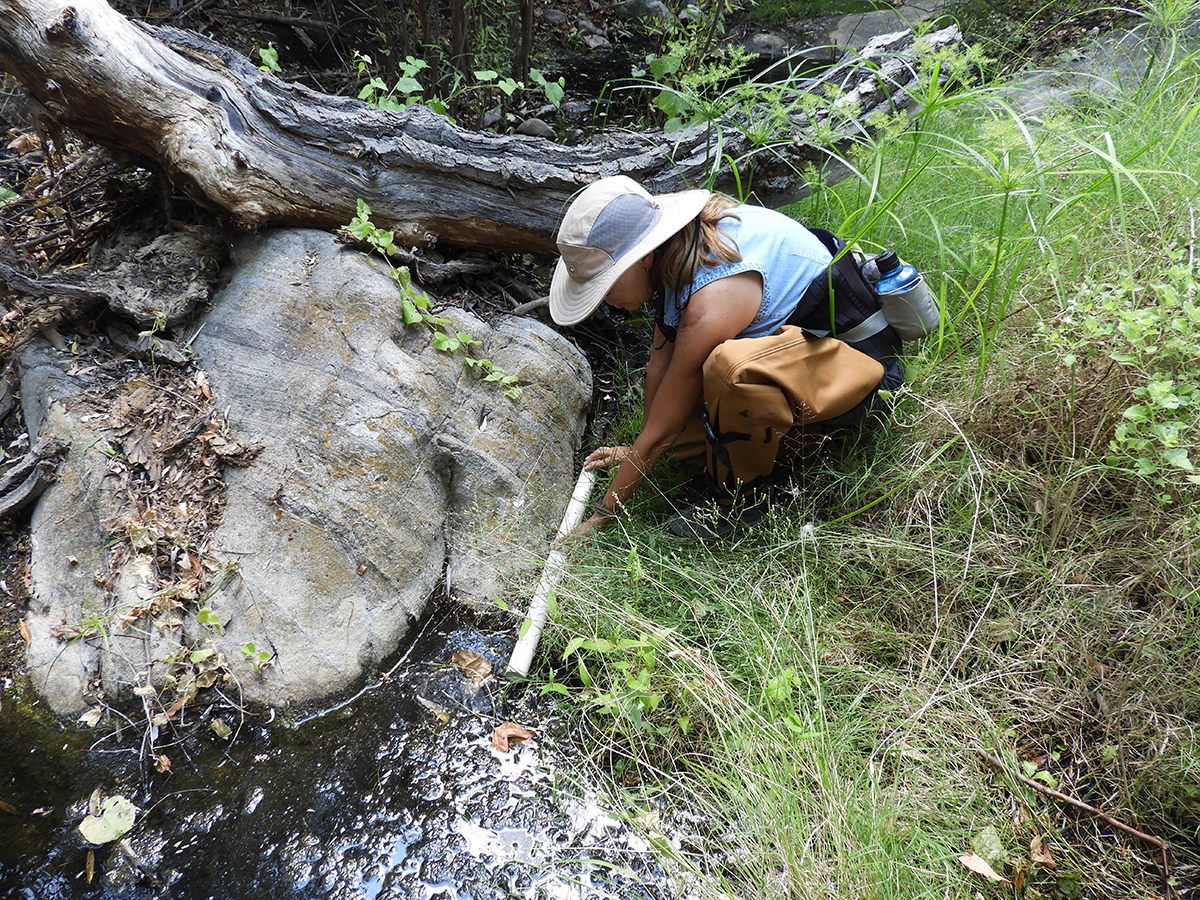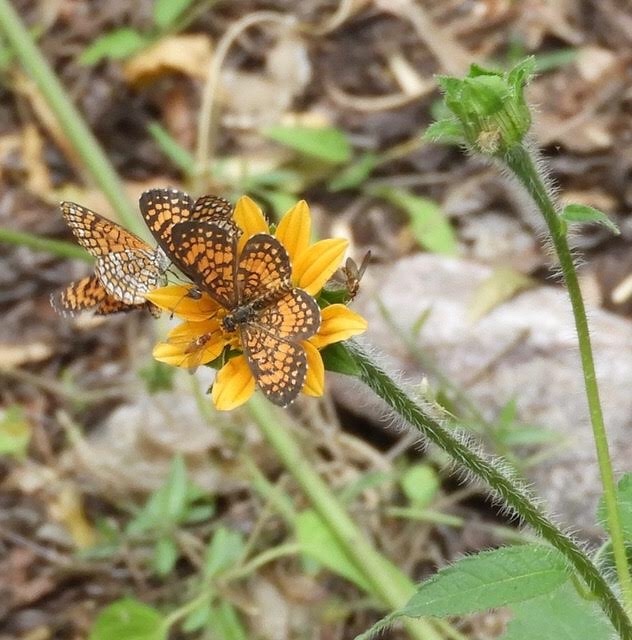by Valarie lee James, Sky Island Alliance Adopt-a-Spring volunteer
Sky Island Alliance Volunteer Log
Monsoon 2017 Visit to the Spring
Our first visit to the spring at the height of the Sonoran Desert Summer exceeded our expectations, yielding water flow, nothing short of a miracle. Now, at the end of the monsoon season, we continue our mission to monitor the spring’s over-all health. September’s mid-nineties temperatures have us sweating under our leg gators.
We hear it before we see it: the spring’s resident Cicadas, the only insects capable of producing such distinctive, sometimes deafening buzz. The cicadas’ percussive audio – the sound of summer in the desert – blasts up the mountain and then slips down into the shade of the spring where massive Walnut and Sycamore trees spread their muscular arms.
Once there, we thrill at the cool air permeated with the fecund scent of rich black mud. We walk carefully, soft and silent on a carpet of moist plant matter: the lush cycling of nutrients in a riparian zone.
After monsoons, growth in the springs is expected to be high but my eye is virtually hijacked by an explosion of green. Knee high bunches of wild grasses and sedges line the banks of the spring. At eye level, seep willow saplings compete with young Walnut. Wild mint and grape vines spread long fingers through the trees. Like a desert animal, I want to drop right then and there, strip off my gators, and press the heat of my belly against the cool bottomland.

Measuring changes in flow through the seasons forms a picture of the year-round health of a spring.
But citizen science calls and we carry on, hiking up the vertical drift to the mouth of the spring where we will measure the length, width, and depth of the pool(s) and then the water quality: the temperature, the conductivity (a measure of dissolved salts), and the PH.
“Look how clear the water is,” my partner marvels. In between floating islands of healthy green algae, the water reflects a turquoise sky beaming through holes in the canopy.
I kneel on the bank and observe. There at the mouth of the spring, honey bees cluster at the smallest point of origin. Flame-skimmer Dragonflies jab the surface of the water, up and down, slaking their thirst. A huge White-lined Sphinx moth flutters down to the water to take a drink, then slips between the grasses on the bank, perfectly camouflaged. Across the water, dense spider webs veil the top of the grasses, successfully netting a multitude of winged food sources coming to water.
Next to me on the bank, ringed by stands of bull grass, spiraled turf presses down like a crop circle. It is a mark, a sign that wildlife has been here, no doubt drank at the spring, and then bedded down in the tall grass. I imagine a mother deer or a fawn resting, allowing themselves a moment to close their eyes. Unable to resist, I curl up too, in the center of the spiral and for a moment, close my eyes. Encircled by a steady hum of insects, I feel the deer’s wakeful rest.
Shortly after, hiking down the drift to the next pool, we pass bones: a deer jaw, small leg bones and hooves. A Deer track shines in the black mud like a carved relief and seed balls of scat dot the path. Farther down, I spot the back end of a coyote running silently through the shadows at the base of the trees.

Monsoon wildflowers swarm with life.
There are no signs of human habitation or visitation. A colorful Mexican blanket we saw on our last visit, woven from natural wool, continues to work into the soil, decomposing organically. The surface has been artfully picked apart by birds and rodents, busy upcycling the fibers. The natural fiber transmutes into primo nesting material, fiber art in the trees, unique decor in the house of the spring.
We pass more color threaded into the biota: wildflowers we have not seen before that correspond to the monsoons: purple flowers from the snapdragon family, yellow/orange Trixis Sunflowers covered with butterflies, and a single Arizona Wild Cotton plant with one spectacular white blossom.
At the final pool, I lay a pipe in a cleft near a boulder where we had discovered water flow on our first visit. The flow coming through the pipe increased by 60% from our summer visit.
As we finished measuring flow, I look up and peering through the trees, see something unfamiliar, vertical shapes I cannot identify from a distance. Determined to solve the mystery, I bushwhack my way down another level, jump water, climb over jagged stumps, and shimmy under deadfall.

Cattails are a sure sign of water!
“Oh my God, Steph!” I yell.
“I see Cattails! It’s another pool!”
Hidden in plain sight: Cattails up to eight feet tall shoot out of a pool measuring twenty-two-foot-long by eight and a half feet wide. The PH level is close to neutral and the water teems with life. I spot at least three different butterflies at this section alone: Mexican Yellows, Checkerspots, and a single handsome Bordered Patch.
“What a surprise!” I exclaim out loud, climbing up the drift again.
“I think this spring is gonna continue to surprise us every time we come,” Steph says, her grin as wide and sunny as the mountain side we scaled to get here.
It’s mid-day now. We feel the ambient air temperature rising even in the spring’s cool reaches. We decide to sit a spell under the largest Sycamore and gather our strength for the trek out. I lean against the tree massive roots rising above the ground. It’s very hot. I close my eyes, breathe, and open them again. Directly in front of me are heaps of dirt. Beyond that are large holes, nine to twelve inches wide at the base of the tree roots. Badger holes! I am sitting on an entire Badger sett, a network of tunnels. I would have missed them entirely had I not been quiet and contemplative, in a state of wakeful rest.
Beyond the Badger holes: more butterflies circle a large patch of diminutive fluted wildflowers. I can identify the butterflies: a yellow Sulfur and a blue-black Pipevine Swallowtail but the wildflowers they love are some kind of composite, frustratingly impossible to name.
The importance of naming cannot be underestimated. Along with the scientific power of discovery, naming what we see bookmarks famed biologist and author Rachel Carson’s “rush of remembered delight,” and furthers a deeper intimacy, a re-enchantment with the natural world. To name is to see, to know, and to remember. Ultimately though, Carson’s writings help us understand that to nurture a life-long sense of wonder and awe “it is not half so important to know as to feel.”

Cicadas are the herald of summer in the Sky Islands.
A leaf the color of raw umber sways lazily down onto the ground. I realize that signs of summer’s end are browning in the Sycamore’s high canopy where the sun rules. As I stare at the leaf, its autumnal color out of place in the emerald green spring, an Arizona Powdered Skipper lands on it. I blink and the moth-like brown butterfly fades into the dried leaf of the same brown hue. Sitting next to me, Steph spots both a mysterious winged arthropod and a hidden cicada exoskeleton clinging to a stem.
In my peripheral vision, a Cooper’s hawk perches in the lower limbs of a tree not fifteen feet. in front of me. Slowly, I turn my head and meet his golden eye. The breath catches in my chest. We both freeze and stare.
Each time I see a hawk I am reminded of the Hawk I saw, we all saw, soaring above the crowd at the Women’s March last winter. 750,000 people in the streets in downtown Los Angeles spellbound by the sight. Later, reports came in of another hawk soaring above the crowd in downtown Denver. I would not be surprised to hear there were many more sightings of hawks soaring high above the crowds, across the Nation that day. According to Indigenous Native peoples, Hawks carry elemental wisdom. They remind us to see the big picture, to rise above identity politics and unite… to keep our eyes on the prize: the earth itself and its most diverse inhabitants in the web of life.
The hawk flies and we get ready to go. First, we pass in and through an “Ecotone,” an important border or transition zone between two biomes; in this case, riparian and grasslands. Beginning the climb up and out, we note changes in color – green grass to dry brown – and then in plant species. We see a huge Hackberry bush bursting with edible berries and a Cholla cactus housing two Cactus Wrens’ nests. As we hike, we flush out at least three different varieties of Sonoran Grasshoppers in an astounding array of size and color, invertebrates not found in the spring and a favorite food of cactus wrens.
It is now over one hundred degrees Fahrenheit and we are thankful for afternoon cloud cover. On the mountain, my hiking sticks ‘stick’ in the vine-like wily grass like knotted hair on the scalp. The monsoonal growth, lusting after life in the sun, does not want to let go of us. We follow deer trails when we can find them, and slip and slide on loose rock hidden under the scrub when we cannot. The climb is arduous and we stop often to chug water. Secretly, we both wish it would rain but we know the monsoon season is at an end. Yet suddenly, we are blessed once more. Great wet drops cool and refresh as we hike back to the car.
Read the first installment of Val’s Volunteer Log from summer 2017.
All photographs by Stephanie Stayton & Valarie Lee James
www.ArtandFaithintheDesert.wordpress.com
Note to the Reader: the whereabouts of this wilderness spring is not revealed to ensure the survival of its unique ecosystem.
